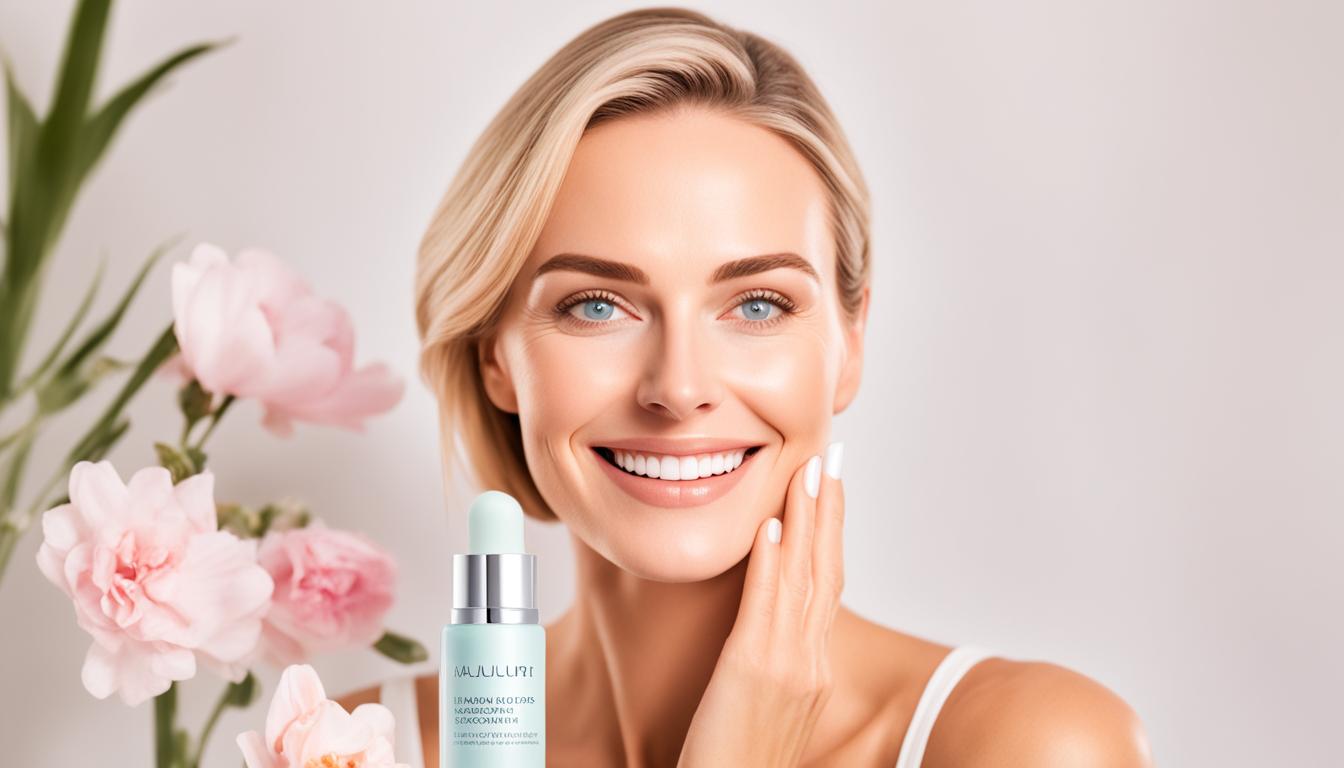Beauty
Smooth Skin with Hyaluronic Acid Research
Your body harbors an essential compound for glowing skin and elasticity—Hyaluronic Acid (HA). Naturally present in your skin, HA boasts an exceptional capacity to retain roughly 1,000 times its mass in water. This makes it an underappreciated powerhouse in achieving a youthful appearance. Pivotal skin-based studies underscore HA’s vital role in moisture retention and aging, placing it at the forefront of dermatological research.
HA is acclaimed for its ability to enhance complexions and maintain youthfulness over time. It transcends mere surface-level benefits, delving deeper into the skin’s structure to bolster its protective barriers and encourage resilience. As dermatological research advances, HA’s complexity and capability in hydrating and supporting skin integrity become increasingly apparent.
Key Takeaways
- Discover hyaluronic acid, a natural component of your skin with profound hydration capabilities.
- Understand the pivotal role of hyaluronic acid in establishing a radiant complexion and supple skin through cutting-edge skin research.
- Learn how the regular application of HA contributes significantly to maintaining a youthful glow and elasticity.
- Find out how advancements in HA skin research are reshaping our approach to skincare.
- Explore the therapeutic benefits and wide-ranging applications of hyaluronic acid in achieving and maintaining optimal skin health.
The Revolutionary Role of Hyaluronic Acid in Skin Hydration
Explore the remarkable effects of hyaluronic acid on skin hydration, a compound pivotal for its luminosity and youthful glow. It has emerged as a cornerstone in achieving soft, plump skin. This molecule excels in water retention, keeping moisture levels optimal for a rejuvenated skin feel.
Understanding Hyaluronic Acid’s Humectant Properties
Hyaluronic acid’s role in skin hydration is unparalleled, thanks to its water-retention capabilities. It acts as a moisture magnet, attracting water from the air and securing it within the skin’s outer layers. Its ability to retain up to 1,000 times its weight in water underscores its importance for well-hydrated skin.
Recent Studies on Hyaluronic Acid’s Immediate Hydration Effects
Scientific research has shed light on the hydration effects of hyaluronic acid, demonstrating swift improvements in skin moisture. A key study highlighted that a single hyaluronic acid serum use can dramatically elevate skin moisture, over 100%. This underscores its role as a superior hydrator, advancing beyond conventional moisturizing approaches.
The Quantitative Impact of Hyaluronic Acid on Skin Moisture Retention
Enduring moisture retention is crucial for lasting skin softness. Hyaluronic acid’s regular application not only boosts moisture immediately but maintains it, improving skin’s dehydration resistance. This ensures hyaluronic acid’s essential position in skincare for lasting hydration and increased skin resilience.
In conclusion, hyaluronic acid stands as an essential element in maintaining constantly hydrated skin. Leveraging this potent humectant’s capabilities moves us closer to an era where skin dryness is obsolete, and perpetual glow is a given.
Exploring the Science Behind Hyaluronic Acid’s Anti-Ageing Effects
The quest for anti-ageing skincare solutions derives from an intricate understanding of skin science. In this arena, hyaluronic acid benefits have emerged prominently within dermatology research. But what cements hyaluronic acid’s status as a pivotal anti-ageing agent?
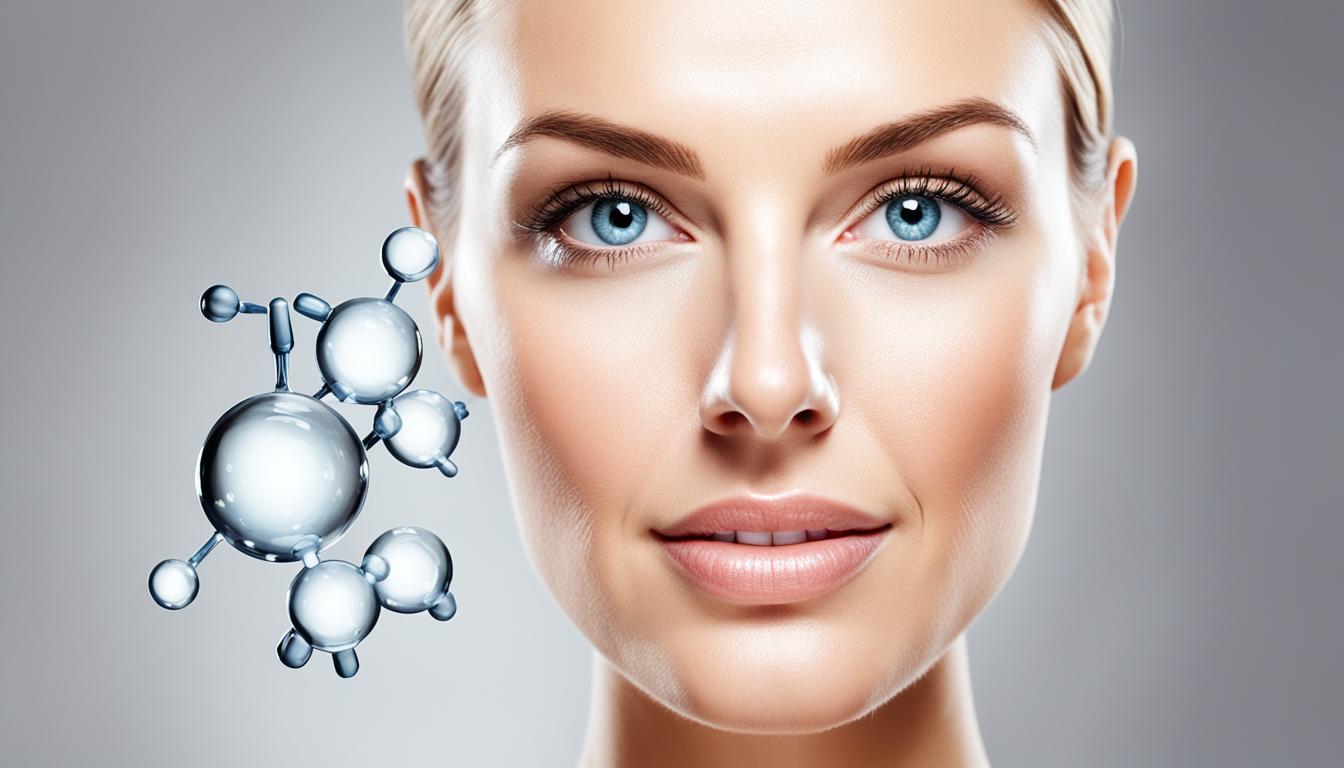
Hyaluronic acid is fundamental in upholding the structural integrity across skin layers. It permeates the skin matrix at a molecular level, delivering essential moisture. This process is crucial for maintaining elasticity, thereby staving off ageing signs, ensuring the skin’s youthful bounce and durability remains intact.
Exploring this topic further, hyaluronic acid exhibits exceptional humectant qualities, capturing moisture to satiate the skin cells’ needs. This hydration minimizes fine lines and early wrinkles, revealing its potency over time. Integrating it into your skincare regimen may yield remarkable anti-ageing outcomes, enhancing your skin’s suppleness and diminishing age-related lines.
Latest dermatology research reveals hyaluronic acid’s dual action: replenishing the epidermis and instigating youthfulness from within. It confronts fine lines, wrinkles, and sagging, positioning itself as a cornerstone of rejuvenation.
Examining its anti-ageing mechanics, hyaluronic acid synergizes with water molecules to fortify the skin’s defense barrier. It stands against external factors that expedite ageing. Additionally, skin science continually validates its role, solidifying its eminent place among skincare constituents.
| Benefit | Scientific Insight | Visible Outcome |
|---|---|---|
| Hydration | Hyaluronic acid can carry 1,000 times its weight in water. | Increased skin moisture and plumpness. |
| Reduced Fine Lines | Encourages skin cell turnover and regeneration. | Diminished appearance of fine lines and creases. |
| Elasticity | Participates in collagen and elastin fibre network synthesis. | Firmer skin with a bounce-back feel. |
| Repair & Protection | Strengthens the skin’s barrier, defending against environmental damage. | Less apparent signs of ageing due to external stressors. |
As you navigate towards the elixir of youth in skincare, consider hyaluronic acid as a key to preserving the anti-ageing glow. Through serums, moisturizers, or specific treatments, its continuous use affirms its value in achieving timeless beauty.
Hyaluronic Acid: The Natural Defence Against Photoaging
Exploring outdoor environments necessitates an understanding of hyaluronic acid’s vital role in combatting photoaging signs. It steadfastly protects your skin, bolstering its resilience against UV damage.
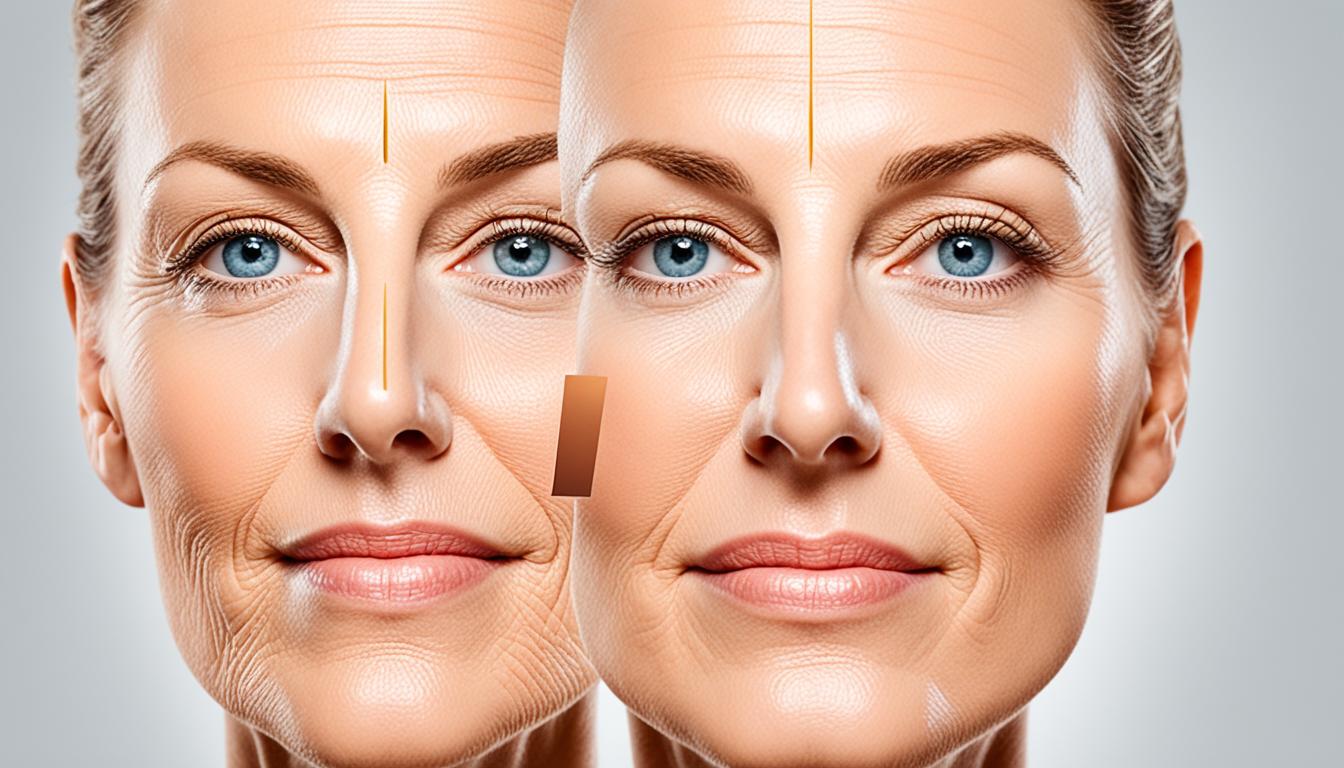
The concept of UV protection extends beyond mere sunscreen application, encapsulating an intrinsic barrier offered by hyaluronic acid. This key skincare ingredient ensures proactive defense, mitigating both immediate and prolonged sun exposure effects.
UV Protection and Skin Ageing Reversal with Hyaluronic Acid
Recent hyaluronic acid research highlights its significant UV protection benefits. Hyaluronic acid aids in reinforcing the skin’s structural matrix, leading to diminished wrinkles and enhanced texture. Such advances herald a transformative approach to managing sun’s aging effects on skin.
Analyzing the Latest Research on Hyaluronic Acid and Sun Damage
Contemporary findings in hyaluronic acid research present promising strategies for sun damage recovery. It promotes cell regeneration and tissue repair, thus alleviating UV radiation’s detrimental impacts, such as exacerbated dryness, reduced elasticity, and premature aging signs. This underscores the importance of integrating hyaluronic acid in everyday skincare routines.
Studies indicate that topical application of hyaluronic acid serums can significantly diminish UV-induced skin degradation, empowing your skin’s natural sun damage reversal processes.
| Dermatological Concern | Benefit of Hyaluronic Acid |
|---|---|
| Decreased Elasticity | Improves firmness and suppleness |
| Dryness and Dehydration | Boosts hydration levels |
| Fine Lines and Wrinkles | Fills in and smooths visible lines |
| UV Ray Damage | Fortifies skin barrier function |
Emphasizing the use of genuine hyaluronic acid products is crucial for assured sun damage reversal outcomes, as corroborated by scientific research. Active engagement in utilizing such products fortifies your skin’s defenses against UV rays, complementing conventional sun protection practices.
How Molecular Weight Influences Hyaluronic Acid Efficacy
Exploring the intricacies of skincare reveals the crucial role of molecular weight in the performance of hyaluronic acid. This determinant controls the penetration and hydration effectiveness of hyaluronic acid on the skin, ensuring it meets its hydrating and rejuvenating objectives.
The Penetrative Abilities of Different Hyaluronic Acid Sizes
Visualize hyaluronic acid as a diversified team, each member with a unique role based on size. The smaller ones, possessing low molecular weight, effortlessly dive into the skin’s lower strata to directly supply moisture. Meanwhile, the larger molecules stay atop, crafting a barrier that secures the skin’s intrinsic moisture.
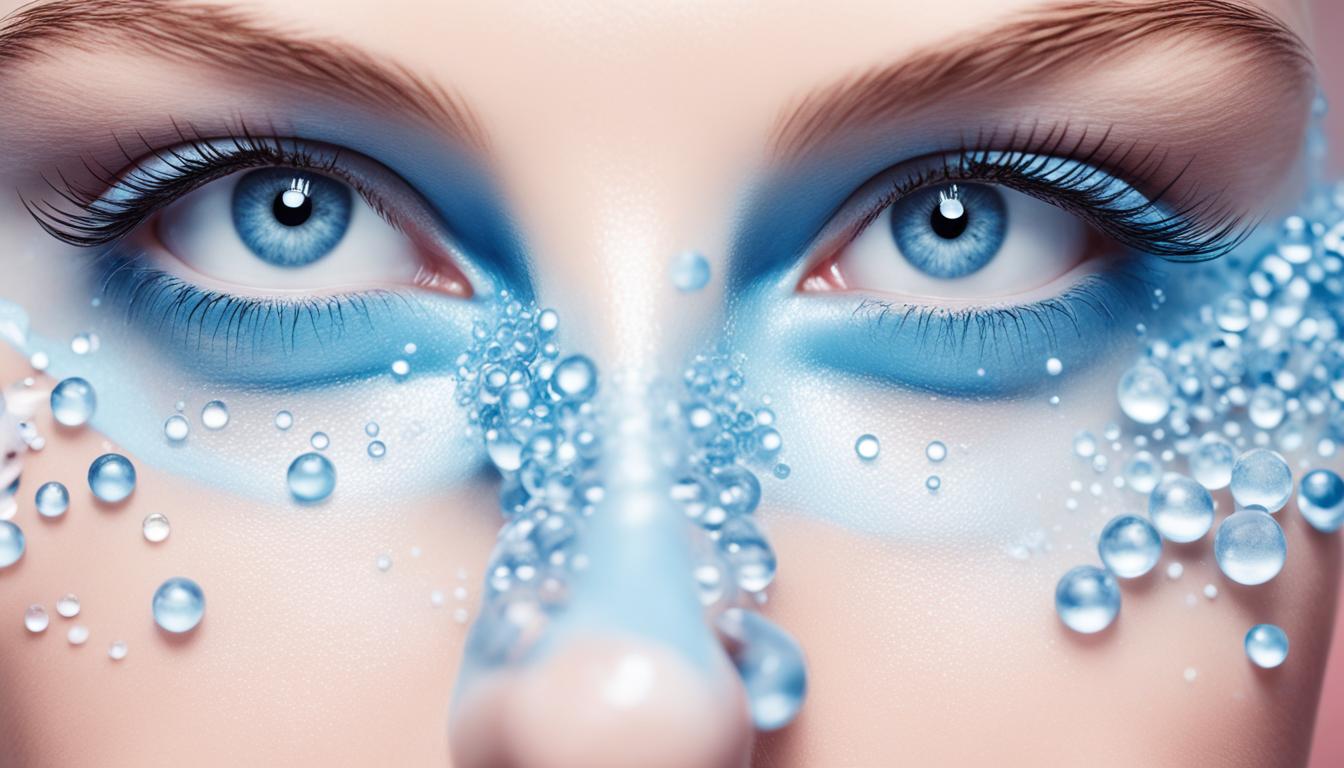
The distinct penetration levels of hyaluronic acid not only modify the sensation upon the skin but influence its look. By infusing the skin from within, low molecular weight hyaluronic acid adeptly addresses fine lines and pronounced wrinkles with remarkable accuracy.
Optimizing Hyaluronic Acid Formulations for Maximum Skin Benefit
Selection of the correct molecular weight in skincare formulations mirrors the precision in choosing a specific tool for a particular task. It concerns striking a fine balance where both low and high molecular weight hyaluronic acids synergize, yielding utmost benefits—intense hydration paired with surface smoothing.
For enhanced performance of hyaluronic acid in skincare, formulations smartly blend diverse molecular weights. This strategy ensures that every skin layer receives precise care to improve and maintain health.
Addressing dry skin, reducing the appearance of wrinkles, or enhancing skin vitality necessitates understanding molecular weight. This knowledge is pivotal in choosing a hyaluronic acid product that delivers genuine results.
Hyaluronic Acid in the Fight Against Fine Lines and Wrinkles
Exploring the realm of skincare reveals Hyaluronic Acid benefits prominently featured in the quest for youthfulness. This potent component has become a cornerstone among Australians for its effectiveness as an wrinkle treatment. Its primary goals include hydrating the skin and diminishing the signs of aging.
The efficacy of Hyaluronic Acid is attributed to its capacity to retain up to 1000 times its weight in water. This capability results in a noticeable fine lines reduction by its plumping effect. It delves beyond superficial hydration, filling the gaps within the skin’s architecture, hence fostering a surface with reduced lines and wrinkles.

Empirical data corroborates the assertion that continuous use of HA-laden products significantly decreases fine lines and wrinkles. With diligent application, observers typically notice the skin becoming more resilient and smoother.
- Fills the spaces between collagen and elastin fibers
- Enhances skin hydration and fullness
- Diminishes the appearance of lines and wrinkles
- Supports overall skin health for a radiant complexion
Hyaluronic Acid’s profound wrinkle treatment attributes make it instrumental in both corrective and preventative skincare approaches. It serves as a key element in fortifying the skin against aging, securing its place in regimens aimed at maintaining smooth, youthful appearances.
The Comprehensive Benefits of Topical Hyaluronic Acid
Topical hyaluronic acid (HA) distinguishes itself markedly within the skincare realm, offering an array of benefits. It transcends its reputation as merely a hydrator, establishing itself as essential for improving skin texture and overall quality. Its efficacy in ameliorating skin conditions is increasingly recognized, underscored by thorough analysis and various case studies.
Case Studies: Topical Applications and Skin Improvements
Recent investigations reveal HA’s significant impact on skin health through consistent use. Enhanced firmness, diminished fine lines, and a more radiant complexion are among the notable benefits observed. These empirical findings substantialize the assertion that incorporating HA into one’s skincare routine could wield considerable advantages.

Corneometry Assessments Demonstrate Hydration Increases
Corneometry, a methodical approach to assessing hydration, validates HA’s hydrating power. Pre- and post-application analysis by corneometry evidences a marked improvement in skin’s moisture content. This uplift in hydration is crucial to sustaining a visage that is both healthy and youthfully vibrant.
| Assessment | Percentage Increase in Hydration | Duration of Application | Participant Feedback |
|---|---|---|---|
| Initial Corneometry Reading | +10% | Immediate Post-Application | “Feels more hydrated.” |
| Follow-Up Corneometry Reading | +44% | 2 Weeks | “My skin’s texture has improved.” |
| Long-Term Corneometry Reading | +58% | 8 Weeks | “Visible skin improvement and hydration.” |
This data solidifies topical hyaluronic acid’s standing beyond a mere trend, highlighting its proven efficacy in enhancing skincare benefits. Its utility spans from hydrating dry skin to offering anti-ageing effects. With corneometry providing measurable proof, the moisturising impact of HA is undeniable and substantial.
The Safety and Tolerability of Hyaluronic Acid in Skincare
The significance of safety and tolerability in skincare is paramount. HA Safety stands out as a crucial element for individuals aiming to preserve their skin’s health. Dermatological Approval signals an ingredient’s mildness and its suitability across various skin types. Notably, hyaluronic acid, celebrated for its moisturizing capabilities, exhibits an impressive safety profile deserving of recognition.
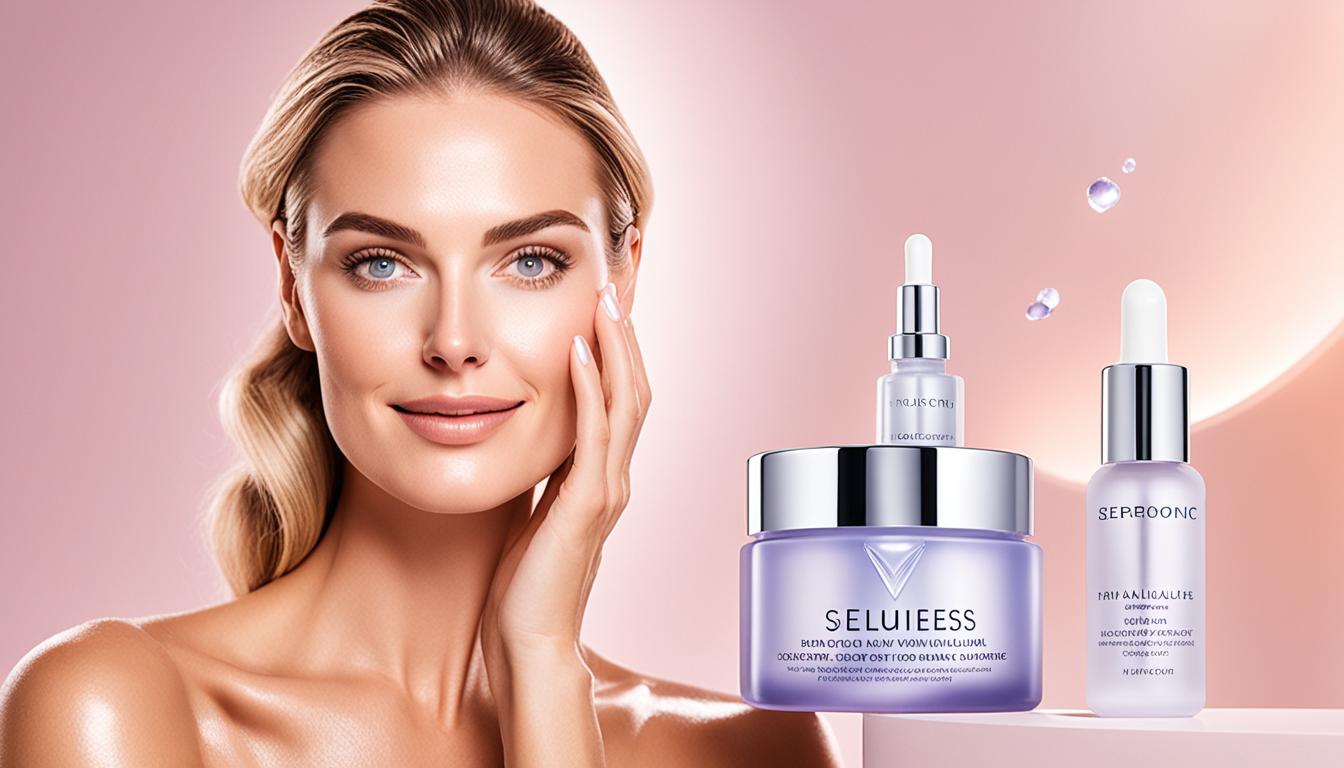
Skin Tolerability underscores the appropriateness of HA for everyday skincare use. This substance, found naturally within the body, has undergone extensive dermatological testing, reassuring its non-irritating properties. Consequently, HA emerges as a adaptable skincare option, embracing everyone who seeks to boost their skin’s moisture and aesthetics.
| Study/Assessment | HA Concentration | Skin Tolerability Results | Dermatological Approval Status |
|---|---|---|---|
| Clinical Trial A | 1% | No significant irritation | Approved |
| Clinical Trial B | 2% | Minimal reactivity in sensitive skin | Approved |
| User Group Study | 1.5% | Well tolerated by all skin types | Approved |
| Longitudinal Study | Variable | Consistent tolerance over time | Approved |
The realm of HA skincare is renowned for its Dermatological Approval. A spectrum of research activities, such as facial swab tests, affirms HA’s effectiveness in reducing irritation risks. This guarantees your confidence in incorporating HA into your skincare regime, knowing its acclaimed status as a benign ingredient.
Thanks to its HA Safety and Skin Tolerability, hyaluronic acid is celebrated among the elite of skincare necessities. Its Dermatological Approval, spanning various concentrations and formulations, cements its role as a universally accepted skincare hero.
Hyaluronic Acid: Beyond Moisturisation to Wound Healing
Hyaluronic acid (HA) plays a transformative role in skin care, extending beyond mere hydration. It promotes healing and regeneration at the cellular level, enhancing key repair processes. Let’s explore the scientific aspects of HA’s capabilities in wound healing and tissue regeneration. This exploration reveals its significant impact.
The Role of Hyaluronic Acid in Cellular Growth and Repair
Hyaluronic Acid is pivotal in cellular repair and growth. Its bioactive properties provide a scaffold that promotes an environment suitable for repair and regeneration. This is crucial in healing tissue, positioning HA as an invaluable asset in skin regeneration. It is effective in treating everything from minor abrasions to complex surgical wounds, showcasing its essential role in natural healing.
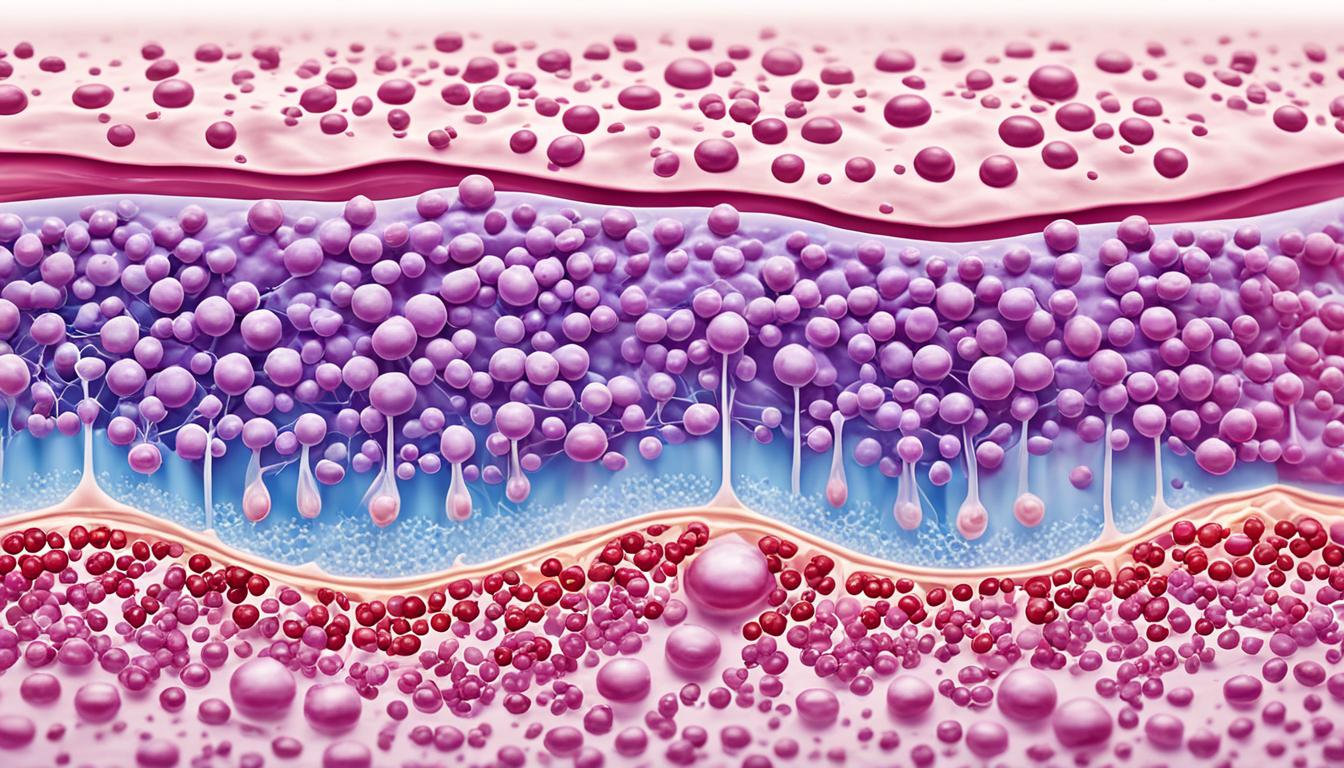
Upon injury, Hyaluronic Acid mobilises to the wound site, attracting essential nutrients and growth factors. This action significantly speeds up the repair process. It underscores HA’s importance in cellular repair and wound closure. These stages are imperative for complete restoration.
Clinical Insights into Hyaluronic Acid and Skin Regeneration
Recent research provides insights into Hyaluronic Acid’s remarkable impact on skin regeneration. With its bioavailability and compatibility with human tissue, HA’s medical applications are invaluable. Below are findings that show HA’s effectiveness in enhancing tissue regeneration.
| Aspect of Regeneration | Role of Hyaluronic Acid | Outcome |
|---|---|---|
| Cellular Proliferation | Provides a matrix for cell migration and growth | Enhanced speed of tissue repair |
| Nutrient Transportation | Transports critical growth factors to the wound site | Optimised healing environment |
| Angiogenesis | Encourages new blood vessel formation | Improved blood supply to support healing |
| Anti-inflammatory Action | Modulates the inflammatory response | Limits scarring and promotes smoother healing |
If you’re dealing with post-surgical healing or aiming for faster recovery from a skin injury, consider using Hyaluronic Acid. It represents a milestone in skin care and medical science. Here, healing becomes quicker, less invasive, and aligns with the body’s natural healing mechanisms. Ongoing research continues to reveal its extensive benefits.
From Laboratory to Bathroom Cabinet: Hyaluronic Acid Product Development
The evolution of the beauty industry demonstrates the complex trajectory of HA Product Development. It represents a meticulous amalgamation of advanced Bio-Engineering Skincare with consumer desires. Serums laden with hyaluronic acid, your daily skincare essentials, originate from intricate bio-engineering processes within state-of-the-art laboratories.
Steps in Crafting Hyaluronic Acid Serums for Consumer Use
Creating the hyaluronic acid serums upon which you depend encompasses numerous pivotal steps. Initially, it involves acquiring superior hyaluronic acid through sophisticated biotechnological processes, notably microbial fermentation, to ensure its purity and effectiveness. Subsequently, HA’s molecular weight is finely adjusted. This crucial step enables the active component to permeate the skin effectively, thereby offering a spectrum of benefits ranging from superficial hydration to profound anti-aging impacts.
Central to product development is the guarantee of safety and efficacy, denoted as Consumer Serums. These serums undergo thorough evaluations during this stage. It’s vital for ascertaining the serum’s effectiveness and its capability in enhancing skin appearance, all the while safeguarding skin health.
Breaking Down the Bio-Engineering of Hyaluronic Acid Skincare
Within the Bio-Engineering Skincare realm, the conversion of raw scientific substances into everyday skincare essentials is quite remarkable. This field requires an exact fusion of scientific discovery and consumer demand, producing products that fulfill their skin-improvement promises. Formulators have to deliberate over aspects such as molecular weight and pH balance. Ensuring that the end HA product is not only efficacious but also amenable for consumer use and consistent in its quality is paramount.
| Development Stage | Description | Consumer Benefit |
|---|---|---|
| Synthesis | Hyaluronic acid is produced via bacterial fermentation, ensuring a pure and sustainable source. | Ethically produced serums with reliable quality. |
| Molecular Calibration | Adjusting the molecular weight of HA to target different skin layers. | Tailored skincare actions from surface hydration to anti-aging. |
| Formulation | Blending HA with complementary ingredients to enhance skin benefits. | Rich, synergistic serums that cater to specific skin needs. |
| Testing and Approval | Conducting clinical trials to validate efficacy and safety. | Trusted products that are both effective and gentle on the skin. |
| Packaging | Designing user-friendly and protective packaging for HA serums. | Easy-to-use products with extended shelf-life. |
The preceding table elucidates the stringent protocol that confirms HA serums adhere to both industry and personal skincare standards. This meticulous attention throughout each phase underscores the commitment of HA Product Development to delivering transformative skin health products.
This extensive HA Product Development culminates in a collection of hyaluronic acid serums gracing bathroom shelves across Australia. At this juncture, the precision of bio-engineering coalesces with the diligence of your daily regimen. The result is a seamless blend that cultivates a pristine, radiant complexion.
Personalised Skincare: Adaptability of Hyaluronic Acid Across Skin Types
The essence of personalised skincare emerges through products that intuitively align with diverse skin types. At the heart of this innovation, HA adaptability positions hyaluronic acid as pivotal in tailored beauty routines. It addresses various concerns such as chronic dryness, excessive oiliness, or signs of ageing, showcasing its ability to deliver specific benefits.
Hyaluronic acid’s unparalleled compatibility spans Fitzpatrick skin types I to VI, catering to every skin hue and tone equitably. This universal approach solidifies hyaluronic acid’s role as the epitome of personalised skincare.
Experience bespoke hydration and rejuvenation, as hyaluronic acid works in harmony with your skin’s unique profile, enhancing texture and vitality, naturally and efficiently.
| Skin Concern | HA Benefit | Suitability |
|---|---|---|
| Dry/Dehydrated Skin | Intense Hydration | All Skin Types |
| Oily Skin | Non-Comedogenic Moisture | All Skin Types |
| Sensitive Skin | Gentle Soothing | All Skin Types |
| Mature/Photoaged Skin | Wrinkle Reduction & Firming | All Skin Types |
Integrating HA adaptability into your skincare regimen yields immense benefits. This action taps into the science of emulating the body’s own hydration processes. Such a scientific approach enhances your skin’s capacity to respond to its unique requirements, underlining the personalized nature of your beauty regimen.
For diverse skin types, hyaluronic acid’s universal efficacy makes its remarkable properties available to all. It fosters a vision of beauty that is inclusive, allowing everyone the chance to achieve well-hydrated, glowing skin.
- Your skin is as individual as your fingerprint; let hyaluronic acid elevate its unique blueprint.
- Explore the full spectrum of benefits that HA brings to personalised skincare, and witness how it caters to the distinctiveness of diverse skin types.
- Regardless of skin type or concern, HA’s profound adaptability offers a customised pathway to skin that not only looks but truly feels its healthiest.
In your search for the right skincare solutions, hyaluronic acid is ready to tailor-fit your skin’s needs, filling in your personal skincare puzzle with meticulous attention and care.
Environmental Stressors and Hyaluronic Acid’s Protective Response
Navigating city streets exposes your skin to an unseen combat. Environmental stressors, like pollutants, unleash oxidative stress and early ageing signs. The skincare hero hyaluronic acid (HA) is emerging for its defence skills.
Research on Pollution, Oxidative Stress, and Hyaluronic Acid’s Counteraction
Increasing research highlights HA’s role in offsetting environmental damage to our skin. The HA protective response acts as a shield, maintaining HA’s molecular structure to guard skin health. External threats, such as smog and UV radiation, launch a cellular attack. Hyaluronic acid intervenes, enhancing the skin’s durability.
Hyaluronic Acid as a Barrier Against Daily Environmental Skin Stress
Visualise hyaluronic acid as a personal defence against continuous environmental skin stresses. It enhances the skin’s barrier function, offering a defence against environmental stressors. HA’s robust nature is crucial for sustaining skin hydration, essential for the skin’s resistance and recuperation from outdoor threats.
| Environmental Factor | Effect on Skin | Role of Hyaluronic Acid |
|---|---|---|
| Pollution | Accelerates ageing, clogs pores | Detoxifies and reinforces skin barrier |
| UV Radiation | Causes photoaging and damage | Provides hydration to repair damaged cells |
| Oxidative Stress | Leads to inflammation and wrinkles | Antioxidant properties mitigate cellular damage |
| Free Radicals | Breaks down collagen, dulls complexion | Protects and revitalizes skin structure |
Incorporating hyaluronic acid in your skincare regime not only hydrates but fortifies against environmental factors daily confronting it.
Comparative Analysis: Hyaluronic Acid Versus Other Skin Hydrators
An intensive skincare analysis is essential when evaluating effective ingredients for skin hydration. The comparison between Hyaluronic Acid and other traditional hydrators highlights the unique moisturising properties of hyaluronic acid.
Hyaluronic acid’s remarkable ability to bind and retain moisture sets it apart. It has become a pivotal ingredient in premium skincare formulations. Let’s explore its distinct advantages and how it compares to other moisturising agents.
Distinguishing Hyaluronic Acid’s Unique Moisturising Capacities
Hyaluronic acid’s capacity to hold up to 1000 times its weight in water is captivating. The quality of hydration it offers surpasses others due to its molecular structure. It ensures prolonged hydration and a visible plumping effect, enhancing both appearance and sensation.
Evidence-Based Comparison of Hyaluronic Acid with Conventional Hydrators
In comparing hyaluronic acid with other hydrators, rigorous research demonstrates HA’s superiority. Clinical studies highlight its enhanced moisture retention and skin smoothness. These findings affirm hyaluronic acid’s premier status in skincare, noting its contribution not only to superficial hydration but also to overall skin health.
- Improved skin texture
- Increased resilience to dehydration
- Enhanced appearance of youthfulness
Including hyaluronic acid in your skincare regime promises notable benefits. Its efficacy and supportive evidence place it ahead of other hydrators, making it a valuable addition.
Hyaluronic Acid’s Role in Cosmetic Dermatology and Aesthetic Medicine
Cutting-edge research has revolutionized cosmetic dermatology and aesthetic medicine. Hyaluronic acid (HA) stands out for its broad utility and remarkable efficacy. It significantly enhances practitioner experiences across the spectrum, from minor improvements to major rejuvenation efforts.
In cosmetic dermatology, HA’s primary function is to improve skin hydration and structure. It is adept at attracting and retaining moisture, which results in a more supple skin texture and a stronger dermis. In the realm of aesthetic medicine, HA-based fillers lead innovation, providing instant volumization and reducing the appearance of aging. The reversibility of these procedures offers assurance and adaptability, aligning with varied aesthetic goals.
HA’s transformative power in cosmetic and aesthetic applications is immense:
Opting for an HA filler means selecting a treatment known for its safety and effectiveness in enhancing facial aesthetics and reducing wrinkles. It anchors anti-aging approaches in both cosmetic and medical fields.
Emerging research is exploring HA’s application in advanced drug delivery, initiating a new chapter in aesthetic medicine. Here, personalized treatments meet specific needs with unprecedented precision.
| HA Application | Benefits in Cosmetic Dermatology | Benefits in Aesthetic Medicine |
|---|---|---|
| Fillers | Restores volume, smoothens deep wrinkles | Contours facial features, reversible adjustments |
| Serums | Enhances skin hydration, promotes suppleness | Maintains post-procedural hydration and health |
| Drug Delivery Systems | Targets specific dermal layers for improved efficacy | Localised treatment for areas needing intensive care |
Cosmetic dermatology seamlessly integrates HA, enhancing its scientific and aesthetic dimensions. Similarly, aesthetic medicine is evolving, promising a future exploiting HA’s full potential. HA facilitates personalised and comprehensive care, ensuring minimal recovery times and optimal outcomes.
- Rehydration: Combatting skin dryness and restoring water balance
- Structure: Supporting skin’s architecture against the natural decline in firmness
- Rejuvenation: Stimulating skin cell turnover and enhancing luminosity
The extensive range of hyaluronic acid applications in both cosmetic and therapeutic fields is astonishing. The continuous advancements in cosmetic dermatology and aesthetic medicine are propelled by HA’s scientifically proven advantages. Such innovations perpetually redefine an industry committed to elevating natural beauty and bolstering self-assurance.
Future Directions in Hyaluronic Acid Research and Applications
In the evolving realm of dermatological science, hyaluronic acid (HA) stays at the forefront, guiding cosmetic innovation and therapeutic advancements. Its research is expanding into new domains, leveraging HA’s powerful biological features. These developments promise significant breakthroughs in healthcare. Such advancements are expected to transform skincare, extend into reproductive biology, and enhance regenerative medicine.
The investigation into hyaluronic acid’s function during embryonic growth has unveiled its essential role from life’s inception. These insights suggest HA could be central in upcoming biomedical studies, possibly affecting fertility treatments and prenatal care. Further, HA’s proven ability in healing wounds and repairing tissues highlights its indispensability in regenerative therapies—a crucial element in developing advanced treatments.
The versatility and increasing clinical importance of HA signal a future filled with unprecedented promise. You may soon learn of its pivotal role beyond cosmetic applications as it emerges in innovative medical treatments and holistic health solutions. The potential of hyaluronic acid to innovate across various medical fields underscores its position as a cornerstone of future health and wellness breakthroughs.
FAQ
What makes hyaluronic acid so beneficial for a radiant complexion?
How does hyaluronic acid improve skin hydration?
Can hyaluronic acid help with anti-ageing?
Does hyaluronic acid provide UV protection and help in reversing skin ageing?
How does molecular weight affect hyaluronic acid’s skin benefits?
How does hyaluronic acid combat fine lines and wrinkles?
What evidence supports the benefits of topical hyaluronic acid?
Is hyaluronic acid safe and tolerable for all skin types?
How does hyaluronic acid contribute to wound healing?
What are the steps involved in developing hyaluronic acid serums?
Can individuals with different skin types use hyaluronic acid-infused products?
How does hyaluronic acid protect the skin from environmental stressors?
How does hyaluronic acid compare with other skin hydrators?
What is the role of hyaluronic acid in cosmetic dermatology and aesthetic medicine?
What future applications of hyaluronic acid are being explored in research?
Source Links
- https://www.ncbi.nlm.nih.gov/pmc/articles/PMC8322246/
- https://www.ncbi.nlm.nih.gov/pmc/articles/PMC3583886/
- https://my.clevelandclinic.org/health/articles/22915-hyaluronic-acid

